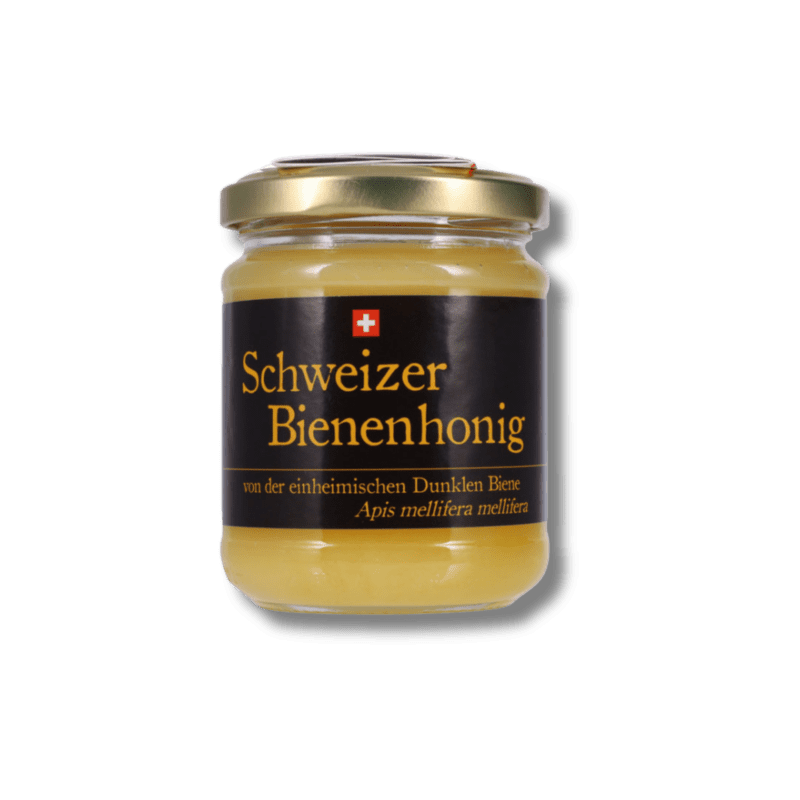Exploring the Dark Bees of Switzerland
Switzerland, renowned for its picturesque landscapes, precision engineering, and delectable chocolates, has another treasure hidden within its alpine beauty – the dark bees. While the term “dark bees” may evoke images of bees with black coloring, it’s essential to clarify that these bees are distinct from their black counterparts. Dark bees, the original inhabitants of Switzerland’s beekeeping heritage, are vital to the country’s ecosystem and cultural identity.
In this blog, we delve into the captivating world of dark bees, exploring their unique characteristics, historical significance, and challenges in the modern era. We’ll also shed light on the conservation efforts dedicated to preserving these iconic bees and the culinary delight they offer through products like Dark Bee Blossom Honey.
So, join us on this journey as we uncover the fascinating story of Switzerland’s dark bees and the sweet rewards they bring to our tables and ecosystems.
Understanding Dark Bees
Dark bees, often referred to as “Apis mellifera mellifera,” are a distinct subspecies of honeybees that have inhabited the Swiss landscape for centuries. Despite their name, these bees are not characterized by a black coloration but rather by their dark brown to almost black appearance, distinguishing them from other bee subspecies. It’s crucial to differentiate dark bees from black bees, as the former holds a special place in Switzerland’s beekeeping history and biodiversity conservation efforts.
Unlike black bees, which may refer to various bee breeds, dark bees specifically denote the original indigenous bees of Switzerland. They boast unique traits and characteristics that make them well-suited to the Swiss environment. Dark bees are known for their hardiness, adaptability, and resilience to harsh mountain climates, making them invaluable assets to Swiss beekeepers.
Furthermore, dark bees exhibit exceptional foraging behavior, efficiently gathering nectar and pollen from various flowers. This versatility allows them to thrive in diverse ecosystems, contributing to the pollination of Swiss flora and the production of high-quality honey.
Understanding dark bees is important not only because of their role within Switzerland’s beekeeping industry but also because of their status as an endangered species. As the original inhabitants of Swiss apiaries, dark bees face numerous threats to their survival, including habitat loss, pesticide exposure, and competition from non-native bee species.
In the face of these challenges, it becomes imperative to appreciate and protect the unique genetic heritage of dark bees. By understanding their distinct characteristics and ecological significance, we can better support conservation efforts to preserve these iconic bees for generations to come.
The History of Dark Bees in Switzerland
The history of dark bees in Switzerland is deeply intertwined with the country’s rich agricultural traditions and cultural heritage. These iconic bees have been vital to Swiss beekeeping practices for centuries, playing a crucial role in pollination, honey production, and ecosystem health.
Dark bees, also known as “Apis mellifera mellifera,” have been native to the Swiss landscape since immemorial. Their origins can be traced back to the forests and meadows of Switzerland, where they adapted to the unique environmental conditions of the alpine region. With their dark brown to almost black appearance, these bees became synonymous with Swiss beekeeping, embodying the resilience and hardiness required to thrive in mountainous terrain.
Throughout history, dark bees have been revered for their exceptional honey-producing abilities and gentle temperament, making them the preferred choices for beekeepers across Switzerland. Their honey, characterized by rich flavors and distinct floral notes, became a prized commodity sought after both locally and internationally.
During the heyday of Swiss beekeeping in the 19th and early 20th centuries, dark bees played a central role in agricultural practices and rural economies. Beekeeping became an integral part of Swiss culture, with beekeepers passing down traditional knowledge and techniques from generation to generation.
However, the advent of modern agricultural practices and industrialization brought about significant changes to Switzerland’s beekeeping landscape. Intensive farming methods, urbanization, and the spread of agricultural chemicals posed existential threats to dark bee populations, leading to a decline in their numbers.
Despite these challenges, efforts to preserve and protect dark bees have persisted. Conservation initiatives and breeding programs have been established to safeguard these endangered bees’ genetic diversity and survival. Organizations, beekeepers, and environmentalists have joined forces to raise awareness about the importance of dark bees and the need for their conservation.
Today, dark bees continue to symbolize Switzerland’s deep connection to nature and commitment to biodiversity conservation. Their presence in Swiss apiaries reminds us of the country’s agricultural heritage and the importance of preserving indigenous bee species for future generations to enjoy. As stewards of the land, it is our collective responsibility to ensure the survival and prosperity of these remarkable creatures for years to come.
Conservation Efforts for Dark Bees
As the original inhabitants of Switzerland’s beekeeping landscape, dark bees face numerous threats to survival in the modern era. However, concerted efforts are underway to conserve and protect these iconic bees, ensuring their genetic diversity and ecological significance are preserved for future generations.
Conservation initiatives for dark bees encompass a range of strategies to address the various challenges they encounter. One of the primary focuses of these efforts is habitat conservation, ensuring that dark bees have access to diverse and suitable environments for foraging and nesting. This includes preserving natural habitats such as forests, meadows, and alpine pastures and creating bee-friendly landscapes in agricultural and urban areas.
In addition to habitat conservation, breeding programs play a crucial role in maintaining genetic diversity within dark bee populations. Selective breeding efforts aim to strengthen desirable traits such as disease resistance, adaptation to environmental changes, and honey production capabilities. By selectively breeding dark bees with desirable characteristics, beekeepers and conservationists can help bolster these endangered bees’ resilience and survival prospects.
Furthermore, education and outreach programs are essential components of dark bee conservation efforts. Raising awareness about the importance of dark bees in Switzerland’s ecosystem, agricultural heritage, and cultural identity helps garner support for conservation initiatives. Outreach activities may include workshops, seminars, and educational materials for beekeepers, farmers, policymakers, and the general public.
Collaboration between beekeepers, conservation organizations, government agencies, and research institutions is essential for the success of dark bee conservation efforts. By working together, stakeholders can pool resources, share knowledge and expertise, and implement coordinated strategies to address the multifaceted challenges facing dark bees.
Ultimately, the conservation of dark bees is crucial for preserving Switzerland’s biodiversity and safeguarding the essential ecosystem services they provide, such as pollination and honey production. By investing in the conservation of dark bees, we are protecting a species and safeguarding the health and resilience of our natural environment for generations to come.
Dark Bee Blossom Honey: A Culinary Delight
Introducing Dark Bee Blossom Honey – a rare and exquisite treat that encapsulates the essence of Switzerland’s rich beekeeping heritage and biodiversity. Crafted by the industrious Apis mellifera mellifera, commonly known as the Swiss Dark Bee, this honey is more than just a culinary delight – it’s a testament to centuries of resilience and adaptation in the face of environmental challenges.

Sourced from the heart of German Switzerland, where the dark bee lineage proudly thrives amidst picturesque landscapes, Dark Bee Blossom Honey offers a sensory journey like no other. With a history dating back to the post-ice age era, the native A. m. mellifera has evolved alongside diverse climates and traditions, giving rise to unique regional tribes across Europe.
Immerse your taste buds in the unparalleled flavor profile of this dark honey, carefully curated by colonies nestled in the foothills of the Alps, particularly in the protected haven of the canton of Glarus. Here, amidst pristine natural surroundings, nearly 60,000 bee colonies proudly bear the dark lineage, ensuring the preservation of this endangered species and its invaluable contribution to ecosystems.
The robust and unique flavor of Dark Bee Blossom Honey reflects the diverse landscapes these bees have called home for centuries. Its deep amber hue and velvety texture perfectly accompany many culinary creations – from drizzling over artisanal cheeses to adding sweetness to your morning tea.
To savor the true essence of Dark Bee Blossom Honey, store it at room temperature and indulge in its complex aromas and flavors with each spoonful. Every jar is a testament to the enduring legacy of the Dark Bee and a celebration of the unique terroir that shapes this rare nectar.
Elevate your honey experience with Dark Bee Blossom Honey – a symbol of nature’s resilience and the artistry of beekeeping traditions passed down through generations. With each taste, you become part of the ongoing journey to preserve Switzerland’s beloved dark bees’ rich biodiversity and cultural heritage.
Conclusion
In conclusion, the story of Switzerland’s dark bees is one of resilience, heritage, and conservation. These iconic bees, the original inhabitants of Swiss apiaries, have played a vital role in the country’s ecosystem, agricultural practices, and cultural identity for centuries.
Despite facing numerous challenges, including habitat loss, pesticide exposure, and competition from non-native species, efforts to conserve and protect dark bees are underway. Through habitat preservation, selective breeding programs, and education initiatives, stakeholders are working tirelessly to ensure the survival of these endangered bees and the invaluable ecosystem services they provide.
As we reflect on the significance of dark bees in Switzerland’s beekeeping heritage, we are reminded of the importance of biodiversity conservation and sustainable practices. By supporting initiatives to preserve dark bee populations and their natural habitats, we contribute to the resilience of ecosystems and the preservation of cultural traditions for future generations to enjoy.
So let us continue to celebrate the legacy of Switzerland’s dark bees, and the remarkable products they bring, such as the exquisite Dark Bee Blossom Honey. With each jar, we honor the enduring legacy of these remarkable creatures and reaffirm our commitment to protecting the natural world. Together, we can ensure that the buzz of dark bees resonates throughout Switzerland’s alpine landscapes for generations to come.





